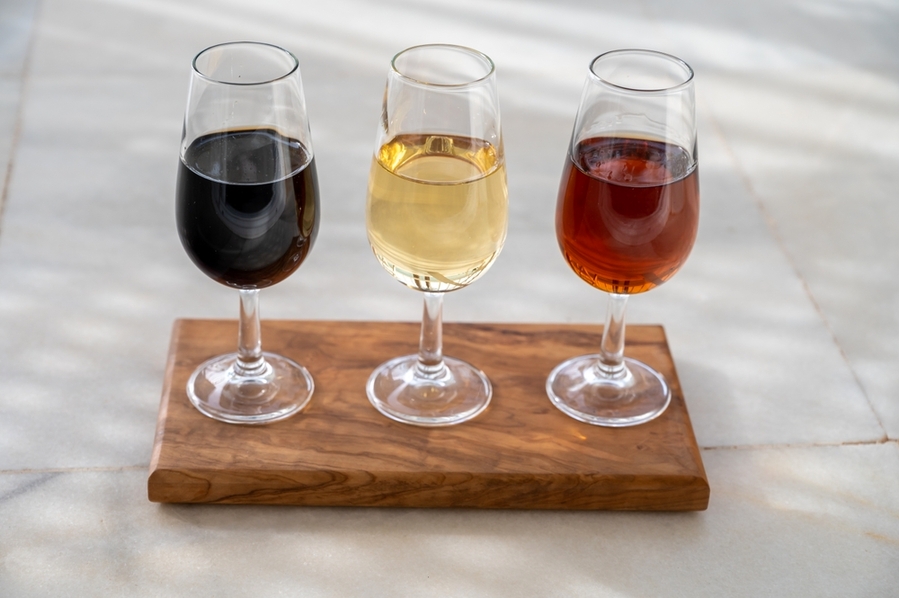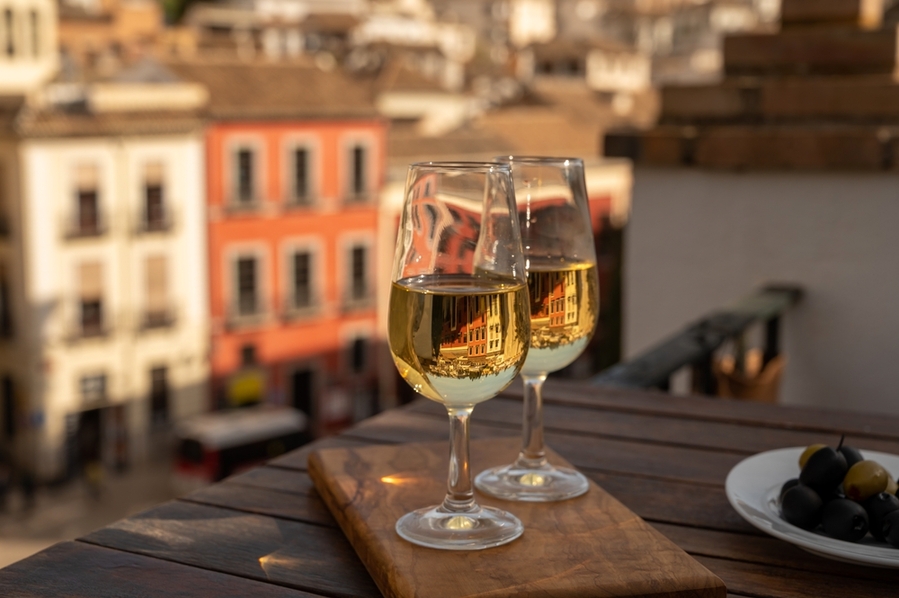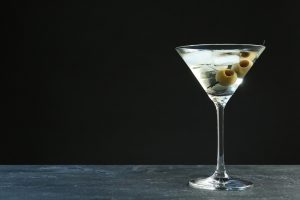
Sherry is more than just a sickly sweet dessert wine. There are many styles to choose from—from bone-dry to coma-inducing sweet options and everything in between.
Sherry is one of Spain’s best gifts to the world. Sherry truly is joy in a glass, but you might wonder, how do you drink Sherry then?
Sherry is a boozy wine with 15-22% ABV and can be served as an aperitif, main meal accompaniment, or dessert. It is served chilled with temperatures ranging between 50ºF and 57°F (10º-14ºC). Pedro Ximénez and Moscatel are exceptionally sweet and best reserved for after the meal.
Today is a deep dive into the world of Sherry because each expression has unique aromas and flavors that pair with different foods. We’ll briefly look at how Sherry is made and the best glassware to serve Sherry. Finally, we’ll dive into the five different kinds of Sherry and the two dessert versions to round things off.
Consider this your Sherry 101 masterclass.
How Is Sherry Made?

Three types of grapes are usually used to produce Sherry: Palomino, Moscatel, and/or Pedro Ximénez, depending on the style the maker wants to make.
The five main styles of Sherry that dominate the market are Fino and Manzanilla, Palo Cortado, Amontillado, and Oloroso.
Before we begin, the official D.O. Jerez-Xérès-Sherry website recognizes ten types of sherries. For brevity, we’ll focus on the main five and two dessert sherries (Pedro Ximénez and Moscatel).
Let’s delve a bit deeper to understand how each is made and what the influence is on the final taste.
Fino and Manzanilla sherries are biologically aged—a thin layer or veil of living yeast, called the flor, is allowed to reside on top of the Sherry as it ages. The flor keeps oxygen away from the Sherry and produces the driest sherries.
The flor is a living and breathing yeast organism and interacts with the wine—the interaction between the flor and wine is highly symbiotic. Yeast cells feed on certain compounds in the wine while also adding new combinations to the wine, thus constantly changing its final composition as it ages.
With no flor present, the Sherry is allowed to oxidize or come into contact with oxygen—Oloroso is primarily produced in this manner.
Between these two methods lies amontillado and palo cortado, which uses a hybrid aging system—the wines begin their aging process under a layer of flor and end it with an oxidative process that ends their élevage.
Many producers use a solera system, and multiple vintages can end up in the final product. You can imagine a solera to look like and operate like a waterfall—the ‘youngest’ wines are at the top of the stack of barrels, and the oldest right at the bottom.
As the older barrels are tapped off for final bottling, wine from the barrel above it (the younger vintage) is added to the barrel below. This ‘trickle down’ effect means each cask is topped up with the previous year’s vintage, mixing old and new and then progressing to the final barrel at floor level.
As a general rule of thumb, the label on the bottle is the average of all the wine ages used during the aging process. Single-vintage sherries also exist, and the label will state this.
But we’re not entirely done yet. Sherry is also a fortified wine meaning grape brandy is either added to the fermenting must or in the final fermented wine.
Timing is everything, and when the brandy is added determines how dry or sweet the Sherry will be. Adding grape brandy also spikes the alcohol content above the levels of everyday table wines, and Sherry can range between 15% and 22% ABV.
How To Serve Sherry

With Sherry packing a punch between 15% and 22% ABV, less is much more in this case. A three-ounce glass of Sherry is more than enough to satisfy your sherry needs.
The general rule is that the sweeter the Sherry (think dessert wines), the smaller the glass should be. Forget about this.
The copita glass can stay in the cupboard—a generic white wine glass with a large bowl and a long stem is all you need to sip Sherry like a connoisseur.
How To Drink Sherry

The world of Sherry spans the entire flavor spectrum from lip-smackingly bone-dry and salty to sickly sweet—this all depends on the style of Sherry you’re serving.
Serving Sherry at the right temperature will help you to appreciate the complex flavors, and serving it with the right food will ensure a match made in heaven.
We’ll dive into the different styles of Sherry and offer food pairings and suggestions, as well as serving temperatures to help you make your next dinner party one for the books.
Take it easy. Sherry is not a quick-drinking wine but should be savored and enjoyed. Instead, opt for an ounce or two at a time to keep the temperature as chilled as possible. In this case, topping up is better.
Remember to pace yourself as well—Sherry has a much higher alcohol content than red and white wines, and you can get drunk rather quickly. The sugar in dessert sherries also doesn’t help with this.
Fino and Manzanilla

This is the driest version of all those we’ll be discussing today. Fino means ‘refined’ in Spanish. Fino sherry is usually aged between four and seven years and is thus consumed very young.
Fino is produced from Palamino grapes and results in a dry, savory wine that’s light-colored. It is mainly made in the El Puerto de Santa María and Jerez regions.
When Sherry is produced in Sanclúar de Barrameda, a coastal town in Spain, it is called Manzanilla Sherry and carries a D.O.-designation. Manzanilla is also lighter in color than traditional Fino sherry. Both of these varieties have a 15–17% ABV.
Food Pairings
Serve Fino and Manzanilla alongside dishes with umami flavors: toasted almonds, salted nuts, cured meats, or olives are excellent choices and will complement your Sherry perfectly.
Other options include seafood dishes, prawns, and salty cheeses. Remember to exercise caution when it comes to salty cheeses—the recommended sodium dosage is 2,400 milligrams per day (a teaspoon of salt is 2,300 mg).
Serving & Storing
Ensure you serve the Sherry between 39 and 48ºF (4–9ºC), the same as when you serve white wine. If you have wine left over, it will last between a few days and a week when sealed with a cork and stored in the fridge.
Palo Cortado

This is one of the rarest types of Sherry—around 100,000 bottles of Palo Cortado are produced instead of 60 million bottles overall.
In the past, Palo Cortado started its journey as a Fino sherry, but something went ‘wrong’; i.e., Mother Nature stepped in. Various factors could contribute to a Palo Cortado, such as more malic acid in the grapes, the yeast acting differently, and the temperature influencing vintage.
The flor failed to develop normally due to a change in the microbiological equilibrium, or the flor did develop. Still, it died unexpectedly, leaving the wine open to oxidation.
Those casks deemed ‘unfit’ for a Fino are taken out of the solera cellar and marked: the Fino mark, a vertical line, or palo is crossed by a diagonal line, or cortado to indicate it’s not a Fino any longer.
Today, Palo Cortado is not so much left to nature to take its course, but instead created and is technically a delicate and lightweight version of Oloroso (which we will come to a bit later).
The tender free-run grape resulting from the grapes’ skins breaking under its own weight, thus releasing its juices, is usually destined to become Fino.
But, instead of allowing the fluid to develop the flor, it is fortified to the strength of Oloroso, and thus it will age through oxidation. You can read more about the fascinating world of Palo Cortado here.
Food Pairings
Food pairings are pretty broad, from grilled fish to cured meats, soft blue cheese or aged cheeses, nuts, and foie gras are welcome accompaniments. A rare sherry deserves some gastronomic pleasures, which you’ll find here.
Serving & Storing
Palo Cortado, ranging between 17% and 22% ABV, is served at a slightly higher temperature when compared to Amontillado (we’ll get to it next) at 57ºF (14ºC).
If you have an open bottle, cork it tightly again and store it at a cool temperature without fluctuating temperatures. It should last a week to a few months.
Amontillado

If Sherry were to have a diplomat, Amontillado would most certainly fulfill that function. It is considered to be the best representation when it comes to Sherry because it undergoes both a biological (flor) maturation and an oxidative maturation.
Amontillado starts its progression as a Fino or Manzanilla sherry, which is aged between two and eight years under the veil of flor; when the flor dies (or is killed by fortifying/raising the alcohol content to 17% ABV), it is considered an Amontillado and allowed to mature further while being exposed to oxygen.
When you serve Amontillado, expect a liquid that can range from light honey to dark amber, but beware, it packs a punch at 16 to 22% ABV.
However, you’ll be rewarded with a dry sherry that boasts a range of rich and complex flavors, including herbs and spices, dried fruit, nutty aromas on the nose, tobacco, and caramel. Sometimes you might even detect a slightly saline taste akin to sea air.
Food Pairings
Amontillado makes an excellent aperitif but can also be served with a range of fare: again, nuts, cured meats, and this time hard cheese are good accompaniments.
For something more substantial, you can turn your attention to seafood such as mackerel, oysters, sardines or white meats, hearty beef consommé, chorizo, or even a paté. Mushroom dishes such as risotto, smoked duck, or smoked chicken are also excellent ideas.
If you need even more recipes, click here for the recipes and guidance on the dishes (even more recipes here).
Serving & Storing
To serve Amontillado, you don’t have to brick up someone in a wall, a la Edgar Allan Poe’s story, The Cask of Amontillado.
All you need is a white wine glass, good company, and a bottle of Amontillado chilled to between 12º and 16ºC (53.6º–60ºF). Older bottles should be served on the warmer side.
After aperitifs or dinner, pop the cork back, and you’ll be able to store your Sherry for a few months in a cool and dark place (please, don’t brick it up in a wall).
Oloroso

With Oloroso, we enter the realm of fully-oxidized and aged sherries—the name means ‘fragrant,’ and flavors such as dried fruits, exotic spices, leather, and polished wood should come as no surprise. The Palomino grapes are fully fermented during the production phase.
The alcohol content inside the barrels is raised to 17% with the addition of grape brandy, preventing the flor from developing. The wine can mature naturally through oxidation. The final Sherry is between 17% and 22% ABV.
Oloroso is naturally dry, but glycerol can give it a subtle sweet taste. However, it is still classified as a dry wine. Oloroso may be slightly sweetened by adding Amaroso or Abocado Sherry. However, Oloroso tends to lose sweetness as it matures.
These days, to read Oloroso on the label, the Sherry may not be sweetened as per the D.O.-regulations. A naturally sweet Oloroso is produced by stopping the earlier fermentation process, resulting in more residual sugars. Vintage Oloroso sherries are also available on the market.
Food Pairings
Oloroso can be paired with pork dishes, casseroles, and matured cheeses. Game and red meat dishes such as slow-roasted oxtail or cheeks are perfect accompaniments to Oloroso.
If you’re a forager, it also pairs excellently with wild mushrooms. Here are some more delicious recipes you might want to consider as well.
Serving & Storing
The best serving temperature is between 53ºF and 61ºF (12º and 16ºC). Leftover Oloroso, stored in a dark and cool environment, will last between four and six weeks, given that it’s adequately corked.
Dessert Wines
Pedro Ximénez and Moscatel grapes generally provide the basis for dessert wines. These sherries aim to preserve as much as possible of natural sugars.
To achieve this goal, grape brandy (or wine alcohol as it is otherwise known) is added during the fermentation process, and the wines are fully oxidized (meaning there’s no flor to protect the wine).
Of course, you can also opt for the cream and medium cream sherries if those are more to your liking.
Pedro Ximénez

The name can also be stylized as Pedro Ximinez, Ximénès, or Jimenez, among other variations. The Sherry is made from the grape variety of the same name, and to use the term, producers must use a minimum of 85% of these grapes.
The grapes are sometimes dried in the sun to concentrate the sugars or picked when they are their ripest. When the grapes are dried in the sun, the process is called asoleo.
The resulting Sherry is a dark ruby color bursting with sweetness and flavors such as grape syrup, jam, honey, and candied fruit while also reminding you of roasted coffee, licorice, dark chocolate, and cocoa.
The nose offers a vibrant bouquet with sweet notes such as raisins (it is raisined, after all), dates, and figs. All of this with an ABV ranging between 15% and 22%, depending on the maker.
Food Pairings
You could skip dessert altogether and serve this extra-sweet dessert wine, but what would the point of dessert then be?
For grownup ice cream, drizzle the Sherry over vanilla ice cream, or serve it with chocolate desserts, crepes, or blue cheeses such as Roquefort or Cabrales.
The key is to serve a dessert that isn’t too sweet; otherwise, it may overpower the Sherry altogether—click here and scroll down for delectable desserts.
Serving & Storing
The ideal serving temperature is between 12 and 14ºC (53º–57ºF); however, younger wines can be served at around 10ºC or 50ºF.
Store your leftover Sherry in a cool, dark place without temperature fluctuations for around a month or two.
Moscatel

Unlike its sweet cousin, Pedro Ximénez, Moscatel isn’t too sweet and offers a sherry that can also be enjoyed as a wine.
You’ll notice orange blossom and jasmine aromas combined with a honey-caramel character. Yet, the finish is slightly dry and bitter. The alcohol content can range anything between 15% and 22%.
Food Pairings
Desserts, pastries like fruit tarts, and others that aren’t excessively sweet are perfect accompaniments to Moscatel. Ice cream is another great option, and so are these recipes.
Serving
Serve Moscatel in a white wine glass, and make sure you’ve chilled the wine to between 12 and 14ºC (53º–57ºF).
Conclusion
Sherry is not just for post-dinner sipping; it is also an excellent ingredient in cocktails.
Considering that there’s a sherry for almost any dish, Sherry is the perfect all-rounder wine to serve during a dinner—from five-course, sit-down dinners to a simple dinner or lunch with a light dessert.
Sherry offers something for everyone’s palate—bring a bit of Spain’s hallmark drink to the dinner table and take your senses on a magical journey.









